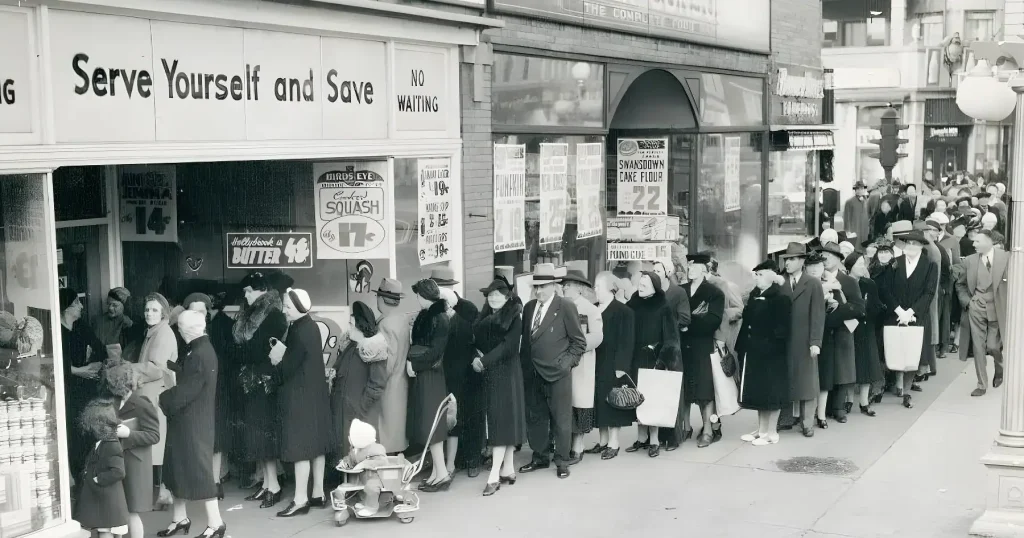Black Friday has become synonymous with massive sales, frenzied shopping, and the unofficial start of the holiday season. But have you ever stopped to wonder how this day transformed into one of the busiest shopping days of the year?
While many view it as just a day of chasing deals and discounts, the true story behind Black Friday is rich and layered, filled with historical twists that might surprise you.
In this blog post, we will explore the history of Black Friday, delving deeper into its origins, evolution, and the impact it has on both retailers and consumers alike.
Black Friday’s Origins in Philadelphia
The history of Black Friday can be traced back to the 1950s when locals and visitors flocked to the stores the Friday after Thanksgiving to take advantage of holiday sales. The day also coincided with the annual Army-Navy football game, which made the situation even worse. As fans traveled to the city for the game, they added more chaos to the already bustling atmosphere created by holiday shoppers.
This unintentional convergence of events led to the entire police force working overtime to manage the chaotic crowds and traffic jams. It was during this time that the Friday after Thanksgiving began to be referred to as Black Friday. By the 1960s, the term had gained widespread popularity, becoming synonymous with the shopping frenzy that characterizes this day.
By 1961, Philadelphia’s merchants and retailers tried to change the name to the “Big Friday” due to the negative connotations it holds. All of this set the stage for what would later become the infamous Black Friday shopping tradition.
The Rebranding of Black Friday
By the late 1980s, retailers successfully transformed the narrative of Black Friday, focusing on profitability rather than chaos. The term “in the black,” referring to businesses turning a profit, became the new association with the day. This shift highlighted day as the time when retailers moved from losses to gains, emphasizing irresistible Black Friday deals and consumer spending.
The rebranding efforts not only altered how people viewed the day but also contributed to the exponential growth of Black Friday as a major shopping event in the United States and worldwide.
The Gold Market Crash of 1869: The First “Black Friday
You may have heard of the gold market crash being referred to as Black Friday. But is it connected to the shopping frenzy we know today?
While it’s often called the original Black Friday, it’s actually a separate historical event where the term was first coined.
The first recorded use of the term “Black Friday” is traced back to a financial crisis in 1869 when financiers Jay Gould and Jim Fisk attempted to corner the gold market.

These investors attempted to exploit their close ties to President Ulysses S. Grant’s administration, hoping to manipulate the market in their favor. They convinced Grant to halt the sale of government gold, aiming to drive prices higher. Along with spreading rumors about the government’s intentions, this caused gold prices to surge to an all-time high. As a result, the price of gold surged, reaching an all-time high.
However, on September 24, 1869, the government intervened and decided to release its gold reserves for sale. This sudden action caused the price of gold to plummet, leading to a panic in the market.
While this event became known as the first “Black Friday,” marking a dark day in U.S. financial history, it has no direct connection to the retail Black Friday we recognize today. But still, the negative connotations of the term may have inspired its later use in describing chaotic shopping events.
Black Friday’s Global Expansion
Black Friday has grown far beyond its origins in the U.S., evolving into a global retail event embraced by countries all over the world. What began as a post-Thanksgiving shopping tradition exclusive to American retailers has now become a key sales event in countries like the UK, Canada, Australia, Brazil, and Germany, among many others. In fact, of the world’s 195 countries, an estimated 50-60% “celebrate” Black Friday.
Retailers in these countries offer their own versions of Black Friday, with discounts and promotions across various sectors, from electronics to fashion. Some regions have even adapted the concept to align with local shopping habits, further expanding its reach.
Breakdown of Countries Participating in Black Friday

The Rise of Global eCommerce
Thanks to the rise of eCommerce and online shopping, shoppers from various countries can participate without stepping foot in a store, accessing deals and discounts from the comfort of their homes, not just in their home countries but in every corner of the world. In 2023, Black Friday online sales reached a record of $9.8 billion.
The Emergence of Social Media
Social media has revolutionized how retailers engage with customers during Black Friday. Retailers now can leverage sophisticated marketing strategies through platforms like Instagram, Facebook, and TikTok, creating targeted ads and personalized shopping experiences to captivate their audiences.
You might be surprised to know that 48% of online shoppers now actively search for Black Friday deals through social media, compared to just 13% who turn to Google.

Winning Black Friday Global Sales with Localization
As Black Friday has turned into a global phenomenon, appealing to consumers from around the world requires a strong focus on localization. To gain potential customers’ trust and drive them to action, localization is not just an option; it’s a powerful tool that should be a top priority. In such a competitive landscape, standing out is about more than just lowering prices.
Successfully localizing your website and campaigns allows you to connect with your audience on a deeper level, engaging both their minds and hearts. It’s all about creating an exceptional user experience where your potential customers feel respected and valued.
In fact, 76% of online shoppers prefer to buy products/services with information in their native language! To win Black Friday sales, you will need to localize:
- Product Descriptions
- Marketing Campaigns
- Checkout Processes
- Customer Support
- User Reviews
And that’s not it. You will need to adopt a comprehensive localization strategy that delivers an authentic, near-local shopping experience for your customers to truly stand out in the global marketplace.
Unlock Global Sales This Black Friday with AsiaLocalize
Need help with your Black Friday preparations? AsiaLocalize is 100% prepared to lift the heavyweights, delivering your translations in the fastest turnaround times.
Our expert team specializes in 120 languages, particularly Asian languages, so you can confidently reach the Asian market.
We tackle even the most complex e-commerce localization projects, helping you navigate the challenges of this massive event. With our experienced in-country professionals and advanced technology, we create tailored website localization and multilingual marketing campaigns that engage your target audience and boost conversion rates.
And here’s the best part: for a limited time, you can get a 5% discount on all our services! Don’t miss out on this chance to enhance your Black Friday success.







